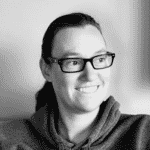Product Management Webinar: Product Leadership
How to get out of the weeds as a Product Leader
In this webinar, special guest, Saielle DaSilva, Product Leader and Director of UX at Cazoo, and host Janna Bastow, CEO of ProdPad and inventor of the Now/Next/Later roadmap will explore how to get out of the weeds as a product leader.
Recently, Saielle’s team experienced hyper-growth, that increased her team to 60 UX folks. As you can imagine, this came with lots of challenges, including how to scale, where to let go, and how to know where letting go was the right thing to do. We tackle these questions and much more in this webinar.

About Saielle DaSilva
Saielle DaSilva helps companies find their customers, meet those customers’ needs, and do it in a way that’s viable for building businesses. She has worked for companies big and small on everything from network infrastructure to IoT and machine learning. Companies like AT&T, Amazon, and Pivotal have worked with Saielle to advance their design, data science, and product management practices.
Saielle advocates for diversity in tech organisations and helps companies apply user centered design to internal processes and hiring. Saielle is currently a product leader and Head of UX design at Cazoo.
Key Takeaways
- How to become a pro at delegating work
- Encouraging and facilitating your team to take on new challenges
- How to change your leadership style to focus on clarity over control
- How to collect and utilise feedback from your own work

[00:00:00] Janna Bastow: Hey, everybody, come on in. This is Saielle. She’s joining us for our webinar here today. And as you get settled in, feel free to pop open that chat that we’ve got here and say hello. Jump in the chat and let us know where you’re calling in.
Personally, I’m here in Brighton, UK and Saielle, how about yourself?
[00:00:19] Saielle DaSilva: I’m in London.
[00:00:21] Janna Bastow: Excellent. So we’ve got to UK massive going on here. How about everybody else? And I can see the people that are coming in here. Now. Another London. Represent. Wonderful. We’ve got anybody from further afield?
[00:00:32] Saielle DaSilva: Uruguay, Dublin, Portland, Oregon. That’s like eight full time zones.
[00:00:37] Janna Bastow: Yeah, nice one good morning. Good morning. Somebody did ask the question here as well.
Which is, will the session be recorded? Yes, this is being recorded as we speak.
A little bit about this webinar before we get started.
So this is a series of webinars that we run here at ProdPad. We call them our Product Experts series because we bring in product experts to come talk to us. The past talks like this one have always been recorded and we have a mixture of firesides like today, as well as presentations from our product experts.
We also have a focus on the content on learning and sharing. So today is going to be recorded and shared, and you are going to have a chance to ask questions. So really excited to hear your questions and see what you all think as well.
Before we kick it off, let me just tell you a little bit about ProdPad. So this is actually a tool that was built by myself and my co-founder Simon. We were product managers ourselves, and we needed tools to do our own jobs and.
We needed something to help us do things like keep track of the experiments we were running in order to try to hit the business objectives that we were given and to solve the customer’s problems that we had and to keep tabs on all the ideas and feedback and everything that made up our backlog.
So building ProdPad gave us control and organization and transparency, and it wasn’t long before we started sharing it with the other product people around us. And today it’s used by thousands of teams around. So it’s a free tool to try. And we even have a Sandbox mode where it has example product management data. So you can see how things like lean roadmaps, OKRs, experiments and everything else all fits together in a product management space. And our team is made up of product people. It’s founded by product people, and it’s made up of product people. So start a trial today, start using it and then get in touch and let us know your feedback.
We’d love to hear from you.
Now let’s get onto the main event. So we’re joined here by Saielle DaSilva, and I actually met sail originally at a ProductTank years ago. It was right after Saielle, had first moved to London some years ago and we’ve stayed in touch to. And Saielle, she’s worked for companies big and small from everything from network infrastructure to IOT and machine learning, working for companies like AT&T, Amazon, Pivotal. She advocates for diversity in tech organizations and helps companies apply user centered design to internal processes.
She’s currently a product leader and director of UX at Cazoo. And she recently grew her UX team to 60 folks. And that hyperscaling came with a lot of challenges, including how to scale, where to let go and how to know where letting go was the right thing to do. So as a product leader who has been there and done that, she’s definitely the right person to speak to about how to get out of the weeds as a product leader.
I think it’s something we don’t talk about. Everybody say hello to Saielle!
Before we get started. Could you tell us more about your career and your work at Cazoo? Like how did you get to where you are today?
[00:03:37] Saielle DaSilva: Yeah, that’s a good question. So my first UX job actually I kind of hacked it together.
I was working at an ad agency in automotive, so I’ve kind of come full circle. But what happened is I was working on an email and it basically had like just a ton of links. And I was like, there’s gotta be a better way to do this. And we were basically shipping micro-sites and email, and I was like, this just feels really inefficient and stupid.
And I made a bet with my boss and I was like, okay, I’m going to design a better way for us to do email. And I’ll make you a bet that my email will outperform your email. And if I win, I want you to give credence to this like UX thing that I’ve been researching. And if you win, I’ll leave it alone, and we’ll just go back to business as usual. Yeah, my email outperformed theirs by like 400%. And I’m like maybe a month and a half later, my boss was like, okay, this UX thing that you’ve been like, suggesting that we do, it seems like you’re really good at it. Do you want to kind of do that full time?
And so from there, I was in charge of the front end team and taking on new challenges, understanding usability and improving user experience across everything that the ad agency did. From there to make a very long story short, I worked for a couple of places. I worked full-time at AT&T and freelanced for Amazon.
And then I went to work for Pivotal Labs, helping them set up a brand new office in Dallas. And basically growing the design practice. And I worked alongside Emily Tate, who is now Managing Director for Mind the Product. And who’s still one of my really good friends. And after that, I moved to London, I worked for a small startup that had hopes of scaling and I wasn’t crazy about it.
So I ended up picking up the job at Cazoo where I’ve worked, as you said, growing the team from literally me and my first hire, who was a researcher, all the way to 60 folks.
[00:05:56] Janna Bastow: That’s amazing. I love that it was all based on kicking off with a bet, you know, just proving that this thing that you do is actually worthwhile and you won the bet!
There’s so much hanging on these these hairpin moments where it could’ve gone either way, but if you were backing it with the knowledge that you had about UX, even if it was a gut feel, but it’s based in the research that you had, then it was a good bet. And sometimes that is the way that you move up in the world is you call BS and say this isn’t right. I think there’s a better way to do it. And give me a little bit of space to show that I can improve this a little bit. And you were fortunate that somebody did give you that space and then gave you that chance to flex more of that UX muscle.
[00:06:40] Saielle DaSilva: So that old boss and I are still really good friends and he currently works for Amazon.
And so, Hi Dave!
[00:06:49] Janna Bastow: That’s amazing. Excellent. And you mentioned working with Emily Tate as well. We did a webinar with Emily Tate just last month. Did a great Product Experts webinar. She was talking about embracing agility in organizations that are built for predictability.
[00:07:06] Saielle DaSilva: That sounds like a really fun topic.
[00:07:10] Janna Bastow: It was, well, you can go back and watch it. Like all of the other ones that we do, we record these because I know that product people are so busy. Right. I mean, that’s one of the fundamental problems that we have.
[00:07:21] Saielle DaSilva: Yeah.
[00:07:22] Janna Bastow: Wonderful. Well, thanks so much for joining us here today.
Now, we’re talking about getting out of the weeds as a product leader, then why is it important to get out of the weeds? What’s at stake? Why not just get your fingers in all the pies?
[00:07:37] Saielle DaSilva: That’s a good question. Well, one you’ve only got 10 fingers and if you’re sticking them in other people’s pies, you’re probably transmitting COVID.
So don’t do that. Clean your fucking hands, please. And thank you. But long story short, one of the reasons that you can’t be in everything all at once is: 1) it’s just not scalable 2) you’re just going to burn yourself out and you’re going to limit the opportunities that your team has to really contribute and grow themselves. And, to me, the best leaders create the conditions of clarity for other people to grow too. You might hear that called servant leadership or any other number of labels. I think the label is a lot less important than the behavior. And that behavior is really about making room for other people to support and help you and being humble enough to know that you can’t do everything.
And so one of the things that I’ve tried to do very consciously is know where my impact was worth the most in terms of like what our team is working on, because you know, you’re the CEO, you know, that like not everything that feels urgent is important and you have to prioritize where to put your attention to make maximum impact.
And that’s something that every leader has to do is know like, okay, there’s, you know, there’s a lot of different things going on, but where can I spend my time and get the most value out of things. Also, I love that Keji is using the chat and Rhonda y’all feel free to like hop in and like drop some comments.
It’s not going to bother me at all. I have ADHD. So if you stimulate me, by like chatting in the right hand side, like great, we can, we can just vibe.
[00:09:24] Janna Bastow: Excellent. I love this crew who joins. And yeah, by all means everybody jumping on the chats and have fun with this. Keji says challenge accepted.
Wonderful. And so you were talking about this this concept of, you know, understanding where your impact is, how do you begin. Finding that, how do you begin understanding that and measuring that and, figuring out whether you’re in the right spaces or not.
[00:09:51] Saielle DaSilva: Yeah. I think one of the ways that I kind of do a sense check on this from time to time is, do I have clarity about what the most important thing I’m working on is, and that’s just a good barometer of where am I spending my time? And am I getting impact from my time? And if ever, I feel like the answer to that question is no. Like, no, I don’t have a clear sense of what the most important thing I’m doing is I either check in with my boss or I do a dump and sort, and I go, okay, what are all the things that I’m working on?
And then how do I like either delegate, de-prioritize or like just move on, right? Like you can only do so much. And so thinking about, okay, what are we working towards as a team? How do I, you know, if it’s important, is there somebody I can give it to? And if it’s not important, can I like just be prioritize it and sense check with somebody that like, Hey, you asked me for, this is it’s still the most important thing we could be doing.
Right. And so communication is actually a really big part of getting out of the weeds. And then, as you start to look for that impact. I think the other thing is like check in with you know, if you’re the most senior product person check in with your exec team. If you’re working as a product manager, day-to-day, check in with your boss, check in with the stakeholders that you work with, right.
About like, Hey, what’s the most important thing we could be doing right now if we had to drop everything, but one thing, what would that be? And, you know, if the answer is something different to what you’re working on, why.
[00:11:32] Janna Bastow: Yeah, absolutely. Absolutely. And I think that’s really key is being able to ask that question of yourself and others.
Is this the most important thing for you to be working on? I think a lot of people make a decision on what to work on and then just blindly work towards it and don’t have the guts or the space to they don’t give themselves the permission to say, actually, I thought this was the right thing to work on when I started the quarter or I started the month or I started this goals list and turns out it’s not.
Things have changed and you know what, I’m going to throw this out because it’s no longer the most important thing for me. You know, just like priorities overall for the business change our PRI our individual priorities. So it should be flexible as well.
[00:12:12] Saielle DaSilva: Absolutely. I think agility—we tend to treat agile as responding to change in terms of the roadmap or the backlog. And we don’t necessarily apply that to ourselves or the behaviors that we engage in. And to me, because I have a design background, the behaviors that we engage in are basically just the same thing as the product decisions that we’re making, because the actions that we choose every single day, are decisions that we’re taking to work towards or not towards something, right. So if I choose to like maximize my impact, whatever that might look like in my role, I have to ask the hard questions about when’s the last time I got feedback on this, or since checked, whether I’m still working on the most important thing. And then, you know, the next question that inevitably follows is: who needs an opportunity to shine. And that’s one of the other things, when you have a team it’s like, who needs an opportunity to like stretch their wings, who’s ready for some growth.
[00:13:12] Janna Bastow: That makes a lot of sense. Delegation itself is such a tricky art and sadly, it’s not really something that we’re ever taught.
You know, we’re taught to do our work. It’s been drilled into us that it’s something that we have to go and complete, not to hand off to others. We’re not really taught this art of how to take work and package it up for other people. And yet it’s something that is hugely needed to be an effective leader.
So like, why is delegation tricky first?
[00:13:45] Saielle DaSilva: I think when you first start delegating and learning to delegate things, one, you’re definitely attached to the work and you’re like, oh, but I know exactly how to do this. And it’s like, I could spend just a half hour doing it. And if I do it myself, I will do it in a half hour.
Again, the challenge to yourself as a leader is going, okay, I can do it in a half hour, but then nobody else gets the opportunity to learn or grow or get feedback or try something new. And then two it’s like, okay, that maybe worked. And I know how to do it for my last company. Assuming that you’re like, you know, mid-weight or further in your career, like maybe it worked at your last company.
Maybe the environment is different. Maybe the situation that you’re working in is different. Okay. Even though what you do could work right off the bat. Like it’s better to give other people a chance to try to solve that problem. And so the other part of delegating, I think, is really hard at first is people tend to delegate the solution that they’re trying to build rather than the problem they’re trying to solve.
And so when I first started managing other designers, I would say, okay, do this, this, this and that. And that is just such an anti-pattern of how to delegate because you’re not making any room for the other person’s creativity and that problem solving. And really what you want to do is communicate. Look, the problem that I’m trying to solve is blah, blah, blah.
I have an idea that might be this, but that’s just input, not direction. You figure it out. And so I make that distinction and that’s one of my. Personal life hacks for delegating effectively is this is input, not direction or asking like a leader that I work with or report to like, okay, would you consider that input or direction?
Right. Cause like the other thing is like, people will be delegating to you all the time too. Right? So delegation’s a two-way street and paying attention to the way other people delegate to you can give you a sense of what works for you and what doesn’t. So the other side of that is going okay. And just asking like active listening questions, like, is this input or direction, right.
Somebody has an opinion. I work with our CTO a lot, his name’s John. And when John has opinions about things, he’ll go, this is literally my uninformed opinion. Do what you think is best, but here’s my opinion. Please consider this input not direction. And so we’ve learned to build that vocabulary into the way that we negotiate ideas and try to get to outcomes that we’re working towards so that we can have a really clear sense of, okay, does it need to look exactly like this or would something generally in the ballpark still work as long as like, you know, it might be different, but it still gets you there.
[00:16:27] Janna Bastow: Nice. I really like that. Those were some really good tips. Do you have any other tips on how to become a pro at delegating?
[00:16:35] Saielle DaSilva: Yeah. I mean, my, my team hates it, but like, they also love it.
You know, they love to hate it because you know, basically whenever somebody observes a problem that they want fixed and they’re like, oh, maybe we should, blah, blah, blah. I don’t know. Like let’s say it’s fix the coffee. Like we don’t like the coffee in the office. I’m like, Hey, you know what?
That sounds like a great idea. Why don’t you figure out who to talk to about that and go make that happen? And it could be, oh, should we, I don’t know, research the blah, blah, blah, for this feature. Yeah, we should. Congratulations. You get to do that. And it drives them a little crazy, but at the same time, they know that we have an opportunity based culture. Right. And so if you come up with ideas, you will be supported. You know, it’s not that you can’t have any support to go do it. It’s not, okay, go do that, and like, please don’t ask me any questions and leave me alone, and I’m too busy for you. There’s an opportunity to go do that. If you have questions, please come ask me.
But otherwise, like I’m ready to just take your idea and see, what’s see what’s up. You know, if he wants some input, you can ask your peers, you can ask your manager, you can ask me, but somebody will be willing to help you. But it sounds like you’ve got some ideas and some passion about this. Why don’t you put something together?
You know, if it’s really important and I’m like maybe we should like sense check that first. I’m just like, why don’t you put some ideas together on paper and give me like five to seven bullet points max, when we can check it out at the end of the day. And so what that does is it lets me critique their thinking early so that by the time they get to building a solution or approaching a solution, whatever it may be, it’s already kind of like vetted for 1) the problem we’re trying to solve and 2) how we should think about solving it. Right. And so another thing that I’m doing all the time is just giving a shit ton of design principles away. So, Hey, maybe choose clarity even over speed when it comes to communication, you know, and like even overstatements are a great way to make like ad hoc principles that can help you shape your team.
And this applies kind of at all levels of delegation, right? If you’re working as a product manager, You can start to negotiate with your engineers about like the product features later, working on, you know, for ProdPad you might choose you know, accessibility, even over speed of implementation.
Right? And you might say accessibility is so important to us that we are going to choose it even over speed. And when you have that discussion with your engineers, guess what the people that you work with will start to echo those things back to you and use that. As a decision-making framework. Right. And so absolutely catchy.
It’s like, it’s really good as a way to lean into the work that you’re doing and thinking about, and it’s a way to broadcast your values, right? The most important thing, I think when delegating is make sure people understand the values that you think with over almost everything else.
[00:19:49] Janna Bastow: That makes a lot of sense.
I really love how you framed that because what you’re doing is giving them the values, the framework, the understanding as to the way that you go about solving problems. You give them space to speak up. If they speak, see a problem and then you give them guidance on how to go about solving them. I think that’s really key thing is not to make it feel as if they spot something they’re now responsible for going to fix it. Like, oh God, I mentioned the coffee problem. Now I have to go source new coffee. Oh, wow. I’m not going to mention the next thing, but if you can guide them through and say, here’s how you can take it to the next step.
Give me those five to seven bullet points and I’ll help critique it. And, we can help figure out what I
[00:20:27] Saielle DaSilva: figure out the right audience for it. And if you need a meeting, who that meeting should be with and all that other stuff,
[00:20:34] Janna Bastow: Yeah, there’s a lot of nuances in there because you’re dealing with people and their their ideas, right?
People come to you with suggestions and thoughts about how they might want to improve things. And it’s really important to hear them out. But at the same time, not make it feel as if they have created work for themselves or created work for others by mentioning things. But if you provide them with a good framework for it, then it can make a big difference.
Now Andrew and the QA has asked a really good question here. You said, how would you suggest providing supportive feedback when delegation routinely results in poor results or delayed delivery?
[00:21:12] Saielle DaSilva: Okay. So that’s a really good question, Andrew. I think it depends on your level of involvement with the person.
And the first question I would ask is, did they misunderstand the outcome that we were working towards? Did they misunderstand the goals? Did they misunderstand the timelines? You know, were the timelines unrealistic? There’s all sorts of nuance there and ultimately to use the standard product managers strapline, it depends.
But if you don’t say that at least once in a product management chat of any kind, like you’re probably doing it wrong. Right. So providing supportive feedback, retrospectives are a great tool and it doesn’t matter what you’re delegating or what’s being done. It’s really important to make sure that people have retrospectives, right.
Is this a team problem or a person problem, right. Is another great sort of like first line of inquiry. And I think if you start to identify, you know, for the sake of argument, if you start to identify that it’s not a team problem, it’s a person problem. You know, Then, cause the question leans into supportive feedback.
So it’s probably a personal issue. So 1) does the person understand what they’re being delegated and what they’re working towards 2) am I as a leader setting clear expectations, 3) does the team have the room to challenge, you know, the delivery timelines and the implementation approach that has been recommended or suggested like, what is the two-way feedback there, right?
Because if the results are poor, like, are you as a leader, close enough to the work to prevent that outcome from happening? You know, are you getting the right level of visibility earlier in the process? Because if you’re routinely ending up in a place where you get poor results, like my question to you.
What could you do to get involved earlier? You want to be supportive, but sometimes that means being in the trenches with somebody. And one of the things I picked up working at Pivotal was an “I do, We do, You do” model. So “I do”, I do something and you watch. “We do”, we do something together based on you having seen me do it once or twice or a couple of times.
Right. And then “You do”, you do, and I watch. And that doesn’t necessarily need to be you. If you’re already strapped for time, there are probably other people in your team who can do that for you. Depending on the size of your team. Right? So, and that’s something that if you teach somebody and you go and you set expectations and you go look, I’m going to do this once or twice with you just to kind of teach you a little bit about how I’m thinking about this.
If I’m solving this problem, you know, whether it’s roadmapping or story writing or backlog management or prioritization, whatever those things are, right? Whatever the ins and outs of day-to-day work are. And then the other thing is supportive feedback. Hey, it looks like we missed the mark on that thing that we were trying to work on.
And we also missed not just quality, but time. Let’s talk a little bit about it. How do you think it went? What could we do differently and see where that person’s self-awareness is as a starting point, right? If the person’s like, well, it was fine. You know, it’s fine. And there’s no room for critique there.
Then that’s a personnel issue. If they’re admitting the mistakes, they might know where some of the blockers are that you can’t see. And I think it’s really important to understand that, as a leader, you inevitably have limited context. So you have to be a little bit curious and just kind of put your Sherlock Holmes hat on and lean into what other people may or may not be experiencing day to day to really understand the situation.
[00:25:11] Janna Bastow: Excellent. And yeah, Andrew said that he really appreciates that response. And like, Andrew, I really liked the I do, We do, You do method. What I like about that is that it highlights where the problems might be like, as you pointed out, it could be with the way that it’s being communicated.
So you might identify it. The I Do area that you actually don’t know how to do this thing when you do it, it actually results in poor quality because you didn’t realize how hard the thing is that you were trying to delegate. You know, it’s easy to say, yeah, go write a thing about this or go build a thing that looks like this, or design a thing that looks like that.
But in reality, when you go to try to do it, you know, This was actually a lot harder and I didn’t communicate this well. At the, we do, it might be pointing out issues with communicating how it’s actually done and at the You do, it might catch things like whether they’ve misunderstood something or whether they’re actually not particularly good at a particular task.
At which point you can identify that and start to work on those particular areas. I love that. That’s great advice. Thanks. So, there’s a fine line between challenging people so that they can grow and learn and challenging them so much that they fail. Can you delegate too much? How do you know when you found that right balance?
[00:26:25] Saielle DaSilva: You can definitely delegate too much. And as we’ve been growing our Munich office, like I have noticed that I have over delegated a little bit and had to get involved again, to make sure that people had clarity and support, like where we’re currently working on internationalizing.
So we’re launching a couple of new markets. And that whole like translation management process has been really heavy. And one of the folks in my team was really struggling with getting some clarity about what level of ownership they should have. And there was a little bit of chaos. And so I had to come in, set some boundaries, and kind of realign folks. And it wasn’t anything that this person was doing wrong. I think really the challenge there was the expectations from their stakeholders was that this person would literally solve everything. And so they were taking that on themselves and actually, I got involved to tell the person that I had delegated to, please delegate more. And actually, let me help you with that. By getting some of the folks who had been basically expecting you to do this, to take more ownership and put more skin in the game. Cause actually they shouldn’t be asking you for this. They should be asking themselves. And they have the tools that they need.
This thing is at this stage in the process, it’s on them to take it from there and make sure that it makes it through, into production and to the end in the right way. So again, looking at that person, I got some feedback that there was concern, like, oh, maybe we’re not, going to hit our deadlines and get it right.
And I was like, okay, I’m gonna ask some questions and take a look. And it turns out that the person that was that I delegated to was just taking on too much themselves and actually just needed to themselves delegate more and distribute the load. And so I was able to do that and we’re in a pretty good place now.
And that was like within the last couple of weeks.
[00:28:28] Janna Bastow: Awesome. That’s great. Congrats. And it’s great that you’re bringing these real world challenges and experiences here. How do you make room for people to take on challenges? If you have somebody who doesn’t want to take on challenges and doesn’t want to push themselves, how do you encourage them to take that step up?
[00:28:47] Saielle DaSilva: Well, the first thing is we look for people who do want to take on challenges in the hiring process. But if you find somebody who’s content and not really pushing themselves or growing a whole lot. One thing is I look for adjacent opportunities. So like, what’s the next biggest container you could reasonably be operating in.
So I wouldn’t take somebody who’s brand new to the team, and go, Here, drive some strategy for us for the next year and a half. Right. But I would go, okay, you’re still working on your technical skills. Is there a course or something, you know, I basically ask myself who’s, who’s kind of coasting or.
You know, and it feels a little bit like being a stark and there’s like blood in the water a little bit. Right? Like who’s got a cut. But, but it is a little bit like hunting and I know that that’s a really shitty metaphor, but like, it is a little bit like just paying attention and being mindful of the team, you know?
Or to use the greenhouse metaphor, which plants in here are ready to bloom. And so who needs a little bit of water, a little bit of soil, maybe a little bit more sunlight to get to the place where they have the support that they need and are really thriving and throwing down roots at that next level.
Right. And so paying attention to that, like I actually had a conversation about somebody in our team today, who I was like, this person seems a little quiet what’s going on there. Are they ready for some new opportunities? Should we be looking at some of the opportunities that are coming up next year?
Should we be considering them for a slightly bigger role? And so. Yes. And you know, the other thing is I talked to the person and so I had a chat with this person who I was like, you know, and I didn’t like go for the jugular on it. I was just like really casual. And it was like, Hey, let’s talk about what’s going on in your team.
What are you feeling? About the level of work that you’re operating at? And they were like, honestly, I’m like a little stressed because I feel like I should be doing more, but I don’t know what to be doing. And I was like, cool, let’s talk about that. Right. So like, most people will highlight that they are eager and ready to take on new challenges. And if you have somebody who’s like, not quite there, maybe it’s a personal life thing. Right. But being a caring and attentive manager can help you prioritize where that person’s at, because we all have ebb and flow in our lives.
Sometimes people need to work to just be a little bit consistent and if you really need something out of that person, cool. But growth for its own sake, isn’t always the healthiest thing to do, especially if somebody has a lot going on personally. So just make sure that you’re balancing.
[00:31:25] Janna Bastow: Yeah, that makes a lot of sense. I really love the gardening metaphor and also the blood one. That’s good too. There’s been a couple of questions that have come in here. Gareth has asked how do you determine whether a task is challenging for your team and you should just give them space and support, or is it something that you should do yourself?
[00:31:47] Saielle DaSilva: I would rather default to letting the team take a stab at things more often than not. There are pros and cons of that method, but I tend to choose to go, you know what? This is probably challenging enough. Here’s something for me to like, could I do it? Yeah. Do what I need to do it with several of you.
Yeah. In that case, it’s a team thing like here, one of you take this on and here’s the problem you’re trying to solve. The thing is as I try to be really concise and really clear. So I try to force myself to argue things and set them up in five to seven bullet points so that people know what’s the most important thing.
Right. And so I will say, Hey, we’re trying to do some research on international expansion in a new market. What we need to understand is these particular behaviors. And I always pick at least like one anti-pattern or one constraint to impose as a way to frame how much work I’m expecting.
Right. So it can be something like, hey, we should probably do some research on this. And I would expect that we don’t spend more than like a couple of days on it because it’s just to solve these questions. Right. These are the questions that we’re trying to make informed decisions on, or you know, when it comes to things that are a little bit closer to product strategy, Hey, I want you to take a look at, I don’t know, maybe like the roadmap for your particular subset of the product.
And let’s make sure that we’re making informed decisions. When’s the last time we did some user research, you know, when’s the last time that we looked at the priorities in the roadmap against the user research needs that we have. When’s the last time that we paid down some tech debt so that we can do cooler stuff in the future.
Right. And so those sorts of questions kind of open up room for discussion. It’s my personal style to force myself to delegate a lot more and just check in frequently. Right? And by checking frequently, I go, I am here. I’m going to ask questions about this and probably in a week or two, if you want me sooner than that, you can certainly ask questions.
Please, don’t get stuck in a rabbit hole, but if you don’t want any input, like I’ll see you in two weeks. And so setting some expectations around when you’re going to check in and letting people know that you’re available is another great way to make sure that something challenging doesn’t go unsupported.
[00:34:11] Janna Bastow: Yeah, that makes a lot of sense. And it sounds like there’s a lot of work here. How big of a team can somebody manage in this sort of way? What’s a reasonable team size
[00:34:21] Saielle DaSilva: Less than the number of managing right now, 13 direct reports right now. And that’s way too many.
But I ideally like six, seven. Something like that. Right. And if your team is bigger than that, you have to choose where you pay attention. Because you can’t do everything for everyone. All the time.
[00:34:44] Janna Bastow: Yeah, that’s absolutely true. Just fitting in things like having one-on-ones with everybody and being able to spend the time to understand, who’s struggling with what and where they are with things. It’s all great if they are all flourishing and doing great with things, but if one or two people start struggling, it’s really important to be able to be there.
Justin asked a question as well. This is related to the fact that we’ve been in this remote working state. Have you found teams are more in the weeds over the last 20 months, especially with remote working or is it more than just virtual meeting overload?
[00:35:25] Saielle DaSilva: Yeah, I think at all levels what tends to happen is you show up for a meeting, you talk about the topic and then you leave and what that ends up doing, is it kind of like, it makes that social connection very, very thin. And you don’t have room for serendipity or just chatting because people are nervous and anxious and like, rightly dealing with being isolated, working from home. It’s a very steep learning curve. And so teams do tend to be more in the weeds I’ve found.
And actually I attended standup with one of our teams today. And again I’m just diving around and like humming birding all over the organization. So today I went to stand up and one thing I noticed is like, this team was just talking about coffee this morning, before standup, they just took a few minutes and they were just talking about coffee versus tea as just a social icebreaker.
Right. And so there’s a question of the day at their stand-up and they kind of get everyone to just say something before they get into talking about work. And so standup’s a little bit longer, but you get that social cohesion that you wouldn’t otherwise have, if all you’re doing is just reporting on like what you did yesterday and what you’re doing today.
And then they end stand up with the joke of the day. There’s always like some sort of funny dad joke or pun or something everyone gets to laugh at, and then you, and stand up on like a little bit of a high note. And so that was really cute and I really liked it. And so that’s something that maybe will work in your team.
[00:37:01] Janna Bastow: Excellent. Does somebody have to like think of the joke every day or there’s a little pool of jokes somewhere?
[00:37:07] Saielle DaSilva: There’s probably a pool of jobs. I should ask them how it works, but like maybe it’s, whoever is leading standup that day. Just the joke of the day at the end or something.
[00:37:17] Janna Bastow: Yeah. Ah, that’s great.
And yeah, I totally agree. You know, having those little moments of social cohesion before and after, just being able to ask, how people’s weekends were and that sort of thing can make a big difference.
You said something recently that I really loved: this concept of focusing on clarity over control in your leadership style. What do you mean by that?
[00:37:41] Saielle DaSilva: So I try to get really clear about the most important things with everyone that I work with. Right. So today I was chatting with somebody and they were in a meeting and I was like, Hey, it it just struck me that you left about halfway through this meeting.
What did you go to? And they told me what they were up to and I was like, okay. Interesting. I think the most important thing for you to be spending your time on is actually hanging out with the people that were in this meeting, because that’s where your strategic input is. And so it was really a gentle way of creating clarity about where this person should be spending their time.
Right. And it’s not control, it’s not. You should do exactly these things. It’s not here are the ideas that you should be implementing. It’s more of a, Hey, where are you spending your time? What are you thinking about when it comes to the problems that you’re solving? And how can I help clarify anything that is ambiguous there?
And the other thing is, again, and I’ve talked about this throughout this whole chat, but like making your values and your decision-making frameworks, really clear, making your priorities really clear and then setting people up for success by making sure that they have the right support.
If they’re taking on new challenges. And so where some people try to delegate solutions. I try to delegate the problem and go, this is the problem that we need solved. And so I love my research team because they—currently, they report to me, so I’m like the chaotic, like, kid in the candy store, who’s like, we should do research on all the things. And then I’m like, oh, there’s like seven of you, which is actually a pretty big research team, but I’m spoiled. And I like my research team. Anyways,
[00:39:29] Janna Bastow: You said all the things right. By all the things, you meant, all the things!
[00:39:33] Saielle DaSilva: Like most, most of the research, like most of the things.
So, you know, inevitably they’re like, okay, what are you trying to solve here? And like, I love that we have that dialogue because it’s something that I’ve taught them. And now they bring them back to me when I forget, right. Or when I’m like juggling a bunch of different things. And so it creates the clarity about what’s important.
And so I love that my research team will ask me, okay, you’ve made this ad hoc request. Is this the most important thing? Because I’m working on A, B and C. Is that really like more important than A, B and C, because if it is, I will drop it, but you need to create the room and the coverage and the runway for me to go do that and drop these other things and help me like communicate to my stakeholders that I won’t be delivering the things that they want at the times that they want.
And so it forces a good amount of clarity and like communication. And the other thing is we challenge each other all the time. So like that very like functional, challenging in that way means that there’s a lot of trust between us because we can have open and honest conversations about priorities and about the work that we’re trying to do.
And so when it comes to delegating, you know, it’s really important to, to set people up by making sure that they understand the problem that you’re trying to solve. And, I try to paint a picture of what would success or awesome look like, right. So, a picture of clarity for some of the research that we’ve been doing, you know, I got, Hey, we need to research blah, blah, blah, whatever it is.
And they go cool. What would awesome look like? Or what are we trying to accomplish with this? And so I come up with like a list of decisions that they could inform if we had that research. Right. So, oh, well we want to know if we should prioritize launching with this feature or that feature, or if there’s any constraints that we’re unaware of or, you know, should we be setting expectations differently in terms of the timelines that we think we’re working towards, because we need more time to learn the things or whatever. Right. And so I try to give my team a little bit of pre-work in terms of these are the decisions that we would be able to make, and this is research, right. But you can do this with product managers as well. Right. If you have a process for pitching ideas, you can always get people to think about what that pitch should or could be and make sure that they’re answering some of those questions about what decisions would we need to make to get there. Right.
Or, if they’re trying to pay down tech debt, for example, right. Hey, it looks like we’ve got a lot of tech debt. I want you to figure out which tech debt is the most important. It would be really great if, Our hypothesis is that in a year and a half, we’d really like to be thinking about like, expanding this strategic, whatever, right? Like increasing maybe revenue per customer, to do that, we know that we’d probably need to change, I don’t know, the order management system or the way that we do billing or whatever it is. Right. And so if you, as a leader, can paint that broad constraint, it means that the team then is free to play in the clarity that you’ve created for them.
Right, here are the boundaries of the playground. Knock yourself out.
[00:42:53] Janna Bastow: Yeah, I like that.
I like that. And so how do you know if you’re doing a good job with delegating and providing this clarity and direction to your team? Like, how do you go about getting feedback as a manager?
[00:43:07] Saielle DaSilva: Ooh, fun one. I just ask, I have ADHD and I just ask very directly, how am I doing?
But not just, how am I doing, which is like, so open-ended that you might not get anything useful. What did you think of that? Do you feel supported? How could I support you better or differently this week? What else would you like me to. What would have made that twice as good. Was that clear? How else could I have made that clearer?
How do you feel about the way this project went? What do you think could have happened differently? What caused that? What else would you say? Is there anything else? Okay. What would you do differently? If we had to take it from the top? What decisions would you like to have made.
[00:44:02] Janna Bastow: I like that.
[00:44:03] Saielle DaSilva: Those are all like, really good examples of ways that—sorry. I have my, I have my user research hat and then I build scripts for myself of things that I can ask. Cause I’m actually really bad at thinking on the spot. So I do a lot of pre-thinking and so I have these scripts in my head of things that I can ask people about work, that’s ongoing, to try to check in on things and make sure that they feel supported and successful.
[00:44:31] Janna Bastow: Yeah, absolutely. To echo what Rhonda has just said in the chat: I think those are really, really good examples, really good concrete examples. And it’s a little bit like a bit of a retro on your leadership style.
You know, being able to get this direct feedback and, it’s only by asking these questions, will you find out if it hasn’t been going well, if you haven’t been clear and I think this is really fundamentally true of so many of these skills that we’re expected to have. We’re not often trained in these things.
They don’t come naturally. They’re the type of thing that come after practice. And the reality is that your first delegation tasks, your first managerial posts, your first chances as a leader, you’re going to make mistakes. We all have, we’ve all been there. But the only way that you can improve on them is by asking these.
Tough questions that sometimes will reflect badly on your own style. But it’s by asking them and being open to the feedback yourself that you can actually improve on them and go, oh, okay. So I could have been clearer here. Well, next time, this is where I’m going to improve on it. And this is the type of stuff that builds leaders.
Leaders aren’t just born and are naturally awesome at it. They have bad one-on-ones they have bad sessions, they have bad experiences, but they do get better at it with these types of processes. And I really liked this really concrete examples. Thank you for sharing those.
[00:45:50] Saielle DaSilva: Yeah, absolutely. The thing is, is like ultimately it’s to me designing like better feedback is the same as designing a product.
Like essentially you need to get to a series of decisions and all you need to do is work backwards from that. So what is the outcome that I’m trying to work towards? Good leadership. How would I know that I have good leadership? Well, I would check in with the people who are customers, if you will, of that leadership, at all levels.
Right? So my manager you know, if you’re the CEO, my shareholders or my customers. If you’re a product manager, maybe you’re a director of product. If you’re a manager or direct reports, as well as the stakeholders that depend on you. And just from time to time, going, Hey, how’s it going? Is there anything that I could be doing better or differently?
What would have made, you know, I love asking and I got this from Julie Zhou. What would have made that twice as good or that might be the Radical Candor
[00:46:55] Janna Bastow: Kim Scott
[00:46:56] Saielle DaSilva: Kim Scott. It’s one of those two it’s either Julie Zhou or Kim Scott, but what would have made that twice as good is a really good, safe question that lets people give you their ideas and input, right?
And again, feedback is input, not always and not often direction. Right? So like you can take it and think about how it applies.
[00:47:20] Janna Bastow: Yep. Perfect. All right. Those are a really, really helpful tips and examples. You know, I think what you’ve said there, it really goes to show that everything we’ve been learning in product, everything we’re good at as product people are the exact same skills that are gonna help us scale up as product leaders.
So I think it’s really important to learn this stuff from a product leader who’s been there and done that.
On that note, I want to say thank you so much to Saielle for joining us here today. It’s been wonderful having you, learned so much.
I think this has been really helpful and I really love the concrete examples and the experience that you’ve pulled on to show us, not just how you got there, but you know what you’ve learned along the way and how we could apply the same things as we move up and learn to delegate and improve our own leadership paths.
[00:48:09] Saielle DaSilva: Absolutely. Thanks so much. If you want to keep chatting, follow me on Twitter.
[00:48:14] Janna Bastow: Excellent. Yes. Follow Saielle on Twitter. She’s amazing on Twitter. She’s @intentionaut, definitely highly recommended.
But thank you so much. Echoing what everyone’s saying in chat here. This has been brilliant. Thanks so much for joining today.
[00:48:27] Saielle DaSilva: Thank you.
Watch more of our Product Expert webinars
How to Stop Roadmap Derailment: Tactics for Avoiding the Agency Trap
Watch our webinar with host, Janna Bastow, Co-Founder of Mind the Product, ProdPad, and inventor of the Now-Next-Later roadmap to hear practical, actionable tactics and techniques to successfully push back on the pressures that threaten to derail your roadmap and defend it against short-term temptations.
How to Drive Growth & Enable Better Decision-Making at Scale with Erin Weigel
Watch our with special guest, Erin Weigel, Principal Designer, Senior Design Manager, and Conference Speaker and host, Janna Bastow, CEO of ProdPad as they explore the transformative power of experimentation in driving impactful product improvements and enabling better decision-making at scale that can propel business growth and success.
How to Convert Your Timeline Roadmap to a Now-Next-Later
Watch this webinar and in exactly 9 steps we’ll show you how to convert your current timeline to a Now-Next-Later roadmap with Janna Bastow, CEO of ProdPad and inventor of the Now-Next-Later roadmap.
How to Navigate Product Leadership: Expert Skills and Coaching as a Leader with Kate Leto
Whether you’re new to product leadership or just looking to upgrade your leadership skills – this webinar is for you. With her extensive experience and unique insights, Kate Leto, Product Leadership Coach, will guide you through the intricacies of product leadership, and also dive into a newly growing leadership technique that integrates coaching into your skillset.
How to Prove To Your Team That ‘Now-Next-Later’ Works Best
There are a lot of stakeholder types, especially in leadership, who still believe they need those dreaded timelines. If you’re desperate to make the move to a more efficient way of roadmapping but are fighting against major resistance in the wider company, then fear not – this webinar is for you.
How to Get Your Company to Move to a Lean Roadmap with Bruce McCarthy
In this webinar with Bruce McCarthy, Founder of Product Culture, we will guide you through the intricacies of implementing lean methodologies, illustrating the art of prioritization, cross-functional collaboration, and iterative planning that are crucial for achieving a nimble and responsive roadmap.
Driving a culture of value-driven growth: The Product Momentum Gap with Dave Martin
Picture this: the Product Momentum Gap, lurking in the shadows, ready to ambush your momentum, slow down your sales, and drain your focus. But fear not! In this webinar, we will explore an arsenal of tools to align your teams to create genuine customer value and drive a culture of value-driven growth.
Tidy Backlog Playbook: From Chaos to Clarity
How do you do it? What tools do you need? How do you convince people you need to do it? That’s where this webinar will help, with our Co-Founder and CEO Janna Bastow. This will be the only playbook you need to achieve the tidy backlog of your dreams and a product process that your teams will praise you for
Mastering the Language of Money: Bridging the Gap Between Product and Executives with Rich Mironov
Watch our webinar with special guest, Rich Mironov, Renowned Product Coach and author of ‘The Art of Product Management’ and host, Janna Bastow, CEO of ProdPad, to enhance your skills, elevate your career, and master the newfound language of money that will captivate executives, engage teams, and accelerate your professional journey.
Master the Art of Communication: Extreme Clarity for Product Managers with Simon Cross
Are you tired of communication pitfalls that lead to misunderstandings, wasted time, and missed opportunities? Do you want to enhance your professional skills and make a lasting impact? Picture this: You communicate with such precision that your team can’t help but be on the same page. Your projects run smoother than a freshly buttered slide in a water park. No more misunderstandings. No more lost hours chasing elusive details. Just pure, unadulterated productivity – all you need is Extreme Clarity.
Making an Impact: Building product when the stakes are high with Randeep Sidhu
Are you ready to uncover the strategies behind making critical product decisions when the stakes are at their highest? Want to discover the secret to critical decision-making and how to build under pressure? Join us for a webinar like no other with special guest, Randeep Sidhu, AI leader, healthcare specialist, and founder of UK’s technology Covid defense, the NHS C19 app, and host Janna Bastow as they explore the art of making critical product decisions in high-stakes environments.
Fireside Chat with Matt Wallaert: How to Build Products That Create Change
Are you ready to unlock the secrets behind building impactful products that create real change? In this webinar with special guest, Matt Wallaert, Founder of BeSci.io (Behavioral Science in organizations), and host Janna Bastow, CEO of ProdPad explore the strategies, methods, and mindsets that can revolutionize the way you approach product development.
Driving Value with Goals: From Humble Planning to Roadmap Hell with Maarten Dalmijn
Do you sometimes wonder if you are actually driving value from your goals? Do you sometimes feel like you are stuck in Roadmap Hell? Are you struggling to know which outputs drive the outcomes you’re looking for? Here’s the deal, discovering how to shift focus from outputs to outcomes can unlock a world of possibilities – so for this webinar, Maarten Dalmijn, Owner at Dalmijn Consulting, and host, Janna Bastow, CEO of ProdPad, present an insightful overview of “Driving Value with Goals” and highlight some of its most crucial concepts.
Finding Profit Streams in Software-Enabled Solutions with Jason Tanner and Luke Hohmann
Are you struggling to generate revenue from your software-based solutions? In today’s economic climate, it’s more important than ever to think critically about the profitability of your products. Yet, many product managers don’t give enough consideration to profit streams. Access our webinar with special guests, Jason Tanner, CEO at Applied Frameworks, Luke Hohmann, Chief Innovation Officer at Applied Frameworks, and host Janna Bastow, CEO of ProdPad as they delve into the concept of Software Profit Streams
Test Your Way to Success: Mastering the Art of Product Idea Testing with David Bland
Watch our latest webinar with special guest, David Bland, CEO and Founder of Precoil, and host Janna Bastow, CEO of ProdPad and inventor of the Now/Next/Later roadmap as they guide you through the process of testing and validating product ideas to increase your chances of success. If you’re looking to reduce the risk of failure for your new product – then this is the webinar for you!
How to Integrate UX Design into Your Product Development Process with Laura Klein
Watch our webinar with special guest, Laura Klein, Director of UX at Indeed and author of ‘UX for Lean Startups’, and host Janna Bastow, CEO of ProdPad as they discuss how UX design plays a critical role in ensuring that products are successful, and how its importance will only continue to grow as the digital landscape evolves.
How to Prioritize Customer Needs with Dan Olsen
We all know that most new product initiatives fail. A big reason for this is that teams are often too focused on the solution they are building and aren’t as clear on the customer problem they are supposed to be solving. In this webinar we explore how to focus on solving customer problems and ensure new product initiatives succeed.
Product Roadmaps vs GIST framework with Itamar Gilad
We explore the pros and cons of two planning methods with their own inventors discussing preferred planning frameworks. On the one side, we have the new GIST framework, and its creator debating that it could in fact replace the traditional product roadmap. And on the other, we have the creator of the Now-Next-Later product roadmap that’s fast replacing the timeline roadmaps across the globe.
Building Impactful Products with Gabrielle Bufrem
Deciding what to build takes effort but how can you ensure you’re building it to success? What prioritization frameworks are actually useful and which just don’t hack it? Watch our webinar to find out!
The Secret to Product Positioning with April Dunford
How do you determine your product’s unique value? What do businesses often get wrong, when it comes to positioning? What’s the secret to positioning your product like a pro? Watch our webinar to find out.
Product Management in Practice with Matt LeMay
Watch our webinar, as we explore product management in practice – none of this in theory malarky, but actually getting into the nitty gritty of what the day-to-day life of a product manager actually looks like.
Dragon Thinking: Is your product strategy really up to scratch?
Join Lucy Spence, Product Director at Appvia (prev. Amazon.), as she explores how ‘dragon thinking’ might be holding back your strategy, and what you can be doing instead.
Product Panel Discussion: ADHD in Product
Join our product panel as they explore and share what it’s like for people with ADHD in the workplace, how they coped, share their stories and dive into the advantages and disadvantages.
The Darkside of OKRs with Christina Wodtke
Join Christina Wodtke, Product Expert and Author of ‘Radical Focus’ and ‘The Team that Managed Itself’, as she explores OKRs and how to create high performing teams.
How to Achieve Success using B2B Innovation Journey with Daniel Elizalde
Join Daniel Elizalde, Product Expert and Author of The B2B Innovator’s Map as he explores the B2B innovator journey and how it can help you to tame uncertainty and discover opportunities to develop products your customers will be eager to buy.
Prioritization Principles: How to Value Stack with Krishna Panicker
Join Krishna Panicker, VP of Product at Airbase explore Value Stacking and how it can help you to decide what opportunities to focus on next to achieve your overall goal.
Finding the Perfect Fit: Product Roadmap and your Product Backlog
Join Liz Love, Chief Commercial Officer at ProdPad, and Head of Product, Kirsty Kearney-Greig as they explore the difference between the product roadmap and the product backlog, and how to use them together to ensure complete transparency in your product processes.
How to Set Effective & Outcome-Led OKRs with Tim Herbig
Join Tim Herbig, Product Management Coach, and Consultant, and host, Janna Bastow, CEO of ProdPad, as they explore the secret to setting OKRs and examine real-world examples of what good and bad OKRs look like.
How to Build a Scalable Multi-Product Strategy with Ibrahim Bashir
Explore key concepts and metrics including KPIs, Flywheels, and S-Curves, and explore how to construct a scalable multi-product strategy.
Product Ops Bootcamp with Melissa Perri
If you want to learn and get to grips with Product Ops, we’ve got the Bootcamp for you! Watch Melissa Perri and host, Janna Bastow as they explore and dive into the world of Product Ops
Building the Dream Product Team from Scratch with Maggie Crowley
If you were to build a product team from scratch, what would you do? Who would you hire? How would you choose your tools? What would your process be? Watch our fireside chat with Maggie Crowley, Olympian and Head of Product at Charlie Health, and host, Janna Bastow, CEO of ProdPad
OKRs vs. Roadmaps Deathmatch with Bruce McCarthy
We kicked off the year with the deathmatch you’ve all been waiting for OKRs Vs Roadmaps – Who will win? Can they work together? Did John Doerr get OKRs wrong?
Culture Clash: How to Make Product and Engineering Work Together Effectively – David Subar
Watch special guest, David Subar, CTO, Chief Product Officer, founder, and managing partner of Interna, and host Janna Bastow, as they explore how to build a great product and engineering culture. They’ll also dive into why the two are so often out of alignment and how to correct it.
Uncover the Secret to Continuous Product Discovery – Teresa Torres
Watch Teresa Torres, Product Discovery Coach, speaker, and author of “Continuous Discovery Habits”, and host, Janna Bastow, as they explore frameworks and core metrics needed to achieve a sustainable approach to continuous discovery and get started on your product discovery journey.
Embracing Lean Product Development – Jeff Patton
What value are we creating and how are we measuring it? Join Jeff Patton, Veteran Product Manager and author of “User Story Mapping” to find out and explore lean product development practices, what teams are getting right and wrong about measuring their work, and how to really focus on the value that you’re creating.
The Path to Becoming a Better Product Manager – Petra Wille
What sets apart the good product managers from the great? Find out in this webinar with special guest Petra Wille, product leadership coach and author of “STRONG Product People”, and host Janna Bastow
Platform Product Strategy & Scaling Product Systems – Ezinne Udezue
Tap into a treasure trove of product insight in this webinar with guest, Ezinne Udezue, VP of Product Management at Procore Technologies and host Janna Bastow, CEO of ProdPad.
Create Your Killer Product Strategy – Ken Sandy
What’s in a killer product strategy that sets it apart? Take a look at examples from real-world companies and craft your next product strategy so that it aligns your stakeholders and motivates your team.
Using OKRs to Win at Work AND in Life – Jeff Gothelf
OKRs are the hot topic in every team around the world. Discover how to apply them successfully, both in your work life and to your personal development.





































